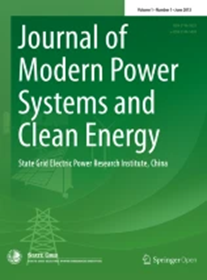Demand Response Potential Estimation Model for Typical Industrial Users Considering Uncertain and Subjective Factors
IF 6.1
1区 工程技术
Q1 ENGINEERING, ELECTRICAL & ELECTRONIC
Journal of Modern Power Systems and Clean Energy
Pub Date : 2025-03-13
DOI:10.35833/MPCE.2024.000764
引用次数: 0
Abstract
Demand response (DR) is a practical solution to overcoming the challenges posed by the volatility and intermittency of the renewable generation in power systems. Industrial electricity demand is growing rapidly, which makes the DR potential estimation of industrial user critical for the DR implementation. In this paper, a unified model for estimating DR potential in the production processes of aluminum, cement, and steel is proposed on the basis of their unique operational characteristics. Firstly, considering the typical characteristic constraints of different industrial users, a DR potential estimation model is developed to capture typical industrial user response behavior under various operational and economic factors. The proposed estimation model is further refined to account for the uncertain and subjective factors present in the actual estimation environment. Secondly, a virtual data acquisition method is introduced to obtain the private virtual parameters required in the estimation process. Then, an industrial user participation threshold is presented to determine whether industrial users may participate in DR at a given time with consideration of their response characteristics. The industrial users may not always act with perfect rationality, and the response environment remains uncertain. In addition, the subjective factor in this paper includes the proposed threshold and the bounded rationality. Finally, an improved DR potential estimation model is proposed to reduce the difficulties in the actual estimation process. The simulation results validate the effectiveness of the proposed estimation model and the improved DR potential estimation model across multiple cases.考虑不确定因素和主观因素的典型工业用户需求响应潜力估计模型
需求响应(DR)是克服电力系统中可再生能源发电的波动性和间歇性所带来的挑战的一种实用的解决方案。工业用电需求的快速增长,使得工业用户的灾备潜力评估成为灾备实施的关键。本文根据铝、水泥和钢铁生产过程中各自独特的运行特点,提出了一种统一的DR潜力估算模型。首先,考虑不同工业用户的典型特征约束,建立了典型工业用户在各种运行和经济因素下的响应行为估计模型;提出的估计模型进一步细化,以考虑实际估计环境中存在的不确定因素和主观因素。其次,引入虚拟数据采集方法,获取估计过程中所需的私有虚拟参数;然后,考虑工业用户的响应特征,提出工业用户参与阈值来确定工业用户在给定时间是否可以参与灾难恢复。工业用户的行为可能并不总是完全理性的,反应环境也存在不确定性。此外,本文的主观因素还包括所提出的阈值和有限理性。最后,提出了一种改进的DR势估计模型,以减少实际估计过程中的困难。仿真结果验证了所提出的估计模型和改进的DR势估计模型在多种情况下的有效性。
本文章由计算机程序翻译,如有差异,请以英文原文为准。
求助全文
约1分钟内获得全文
求助全文
来源期刊

Journal of Modern Power Systems and Clean Energy
ENGINEERING, ELECTRICAL & ELECTRONIC-
CiteScore
12.30
自引率
14.30%
发文量
97
审稿时长
13 weeks
期刊介绍:
Journal of Modern Power Systems and Clean Energy (MPCE), commencing from June, 2013, is a newly established, peer-reviewed and quarterly published journal in English. It is the first international power engineering journal originated in mainland China. MPCE publishes original papers, short letters and review articles in the field of modern power systems with focus on smart grid technology and renewable energy integration, etc.
 求助内容:
求助内容: 应助结果提醒方式:
应助结果提醒方式:


